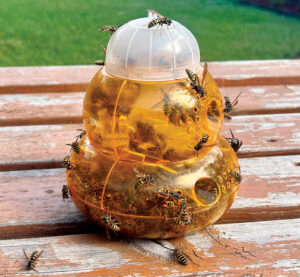The news reports on the wasp and hornet populations affecting the region
By BRENDAN MILLER on August 29, 2024.

 Due to persistent heat waves and the lack of moist, cool weather in the summer, the wasp and hornet population has skyrocketed this year. – NEWS PHOTO SCOTT SCHMIDT
Due to persistent heat waves and the lack of moist, cool weather in the summer, the wasp and hornet population has skyrocketed this year. – NEWS PHOTO SCOTT SCHMIDT[email protected]
While traps, kits and do-it-yourself projects are effective methods of reducing the wasp population, the region will not see relief from the black and yellow striped insects until the weather breaks. Wasps, hornets and bees continue to enjoy a consistently hot summer, which has led to an increase in their numbers as many colonies continue to grow as more eggs hatch throughout the season. Jessica Deacon-Rogers, education program coordinator at the Helen Schuler Nature Centre in Lethbridge, explains that Medicine Hat and surrounding areas usually experience a big increase in the wasp, hornet and bee population in August due to the lack of cold weather. “Because this is a colonial species, there tend to be a lot of them and their numbers increase throughout the summer,” explains Deacon-Rogers. “So if we have a summer where it’s not really cold or really wet, they don’t die.” Typically, wasps and hornets are more aggressive than bees and the most troublesome native wasp species in southern Alberta include the Arctic and Common Yellowjacket, as well as the Blackjacket. All species are black with yellow and white stripes along their exoskeleton. The most common hornet species Alberta comes into contact with is the Bald-faced Hornet, which is distinctively black and has small white circles around its abdomen near its stinger. “We have really big numbers this time of year because they’ve reached their maximum capacity, so to speak. So you see a lot more of them because there are a lot more of them that are still alive.” During the winter months, very few native bees, wasps and hornets remain alive. Usually it’s just a few workers and a queen, who can survive the cold winter months by burrowing underground. “The queens go underground by finding cracks in the ground to burrow into or loose soil to burrow into,” says Deacon-Rogers. “They hatch in piles of rubble, anywhere that has a lot of logs stacked up that create a barrier between them and the cold.” Once spring arrives, the queen usually begins laying eggs and producing more workers. She starts small but gets bigger as the weather becomes more favorable. Deacon-Rogers explains that there are several different types of solitary wasps, hornets and bees, but the ones that cause problems for residents usually come from large colonies. Food is another reason wasps and hornets become more active this time of year, as it becomes harder for them to find food sources. “There are tons of wasps and hornets because it’s still warm outside, it’s not cold at night, which causes some of that population to die, and they’re looking for food,” explains Deacon-Rogers. Although there is no specific timeline for when to expect population declines, Deacon-Rogers says people will notice a big drop in populations around the time when plants in the garden start to die. “When your garden starts to wither, when the first frosts arrive and the nights get cooler, the animals, being invertebrates, cannot generate their own heat and therefore have trouble surviving in cooler temperatures.” 17
-16

